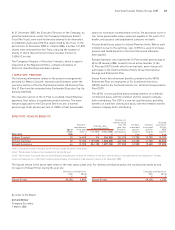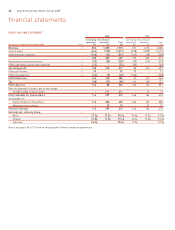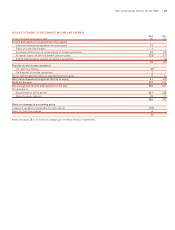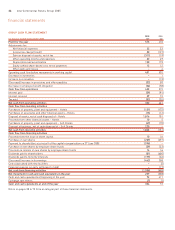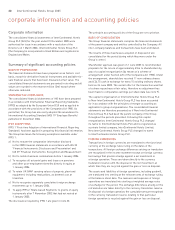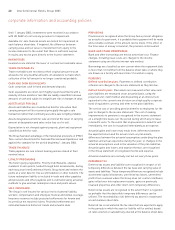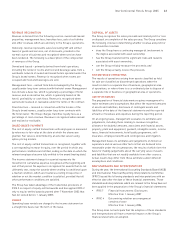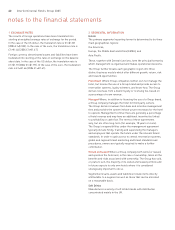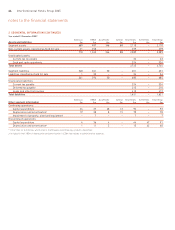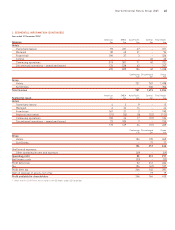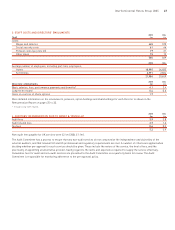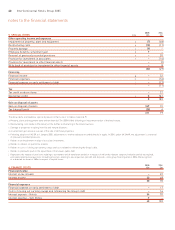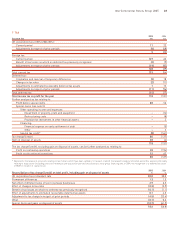Holiday Inn 2005 Annual Report Download - page 42
Download and view the complete annual report
Please find page 42 of the 2005 Holiday Inn annual report below. You can navigate through the pages in the report by either clicking on the pages listed below, or by using the keyword search tool below to find specific information within the annual report.
Until 1 January 2005, investments were recorded in accordance
with UK GAAP at cost less any provision for impairment.
Available-for-sale financial assets are tested for impairment at
each balance sheet date. If impaired, the difference between
carrying value and fair value is transferred from equity to the
income statement to the extent that there is sufficient surplus
in equity; any excess goes directly to the income statement.
INVENTORIES
Inventories are stated at the lower of cost and net realisable value.
TRADE RECEIVABLES
Trade receivables are recorded at their original amount less an
allowance for any doubtful amounts. An allowance is made when
collection of the full amount is no longer considered probable.
CASH AND CASH EQUIVALENTS
Cash comprises cash in hand and demand deposits.
Cash equivalents are short-term highly liquid investments with a
maturity of three months or less that are readily convertible to known
amounts of cash and subject to insignificant risk of changes in value.
ASSETS HELD FOR SALE
Assets and liabilities are classified as held for sale when their
carrying amount will be recovered principally through a sale
transaction rather than continuing use and a sale is highly probable.
Assets designated as held for sale are held at the lower of carrying
amount at designation and sales value less cost to sell.
Depreciation is not charged against property, plant and equipment
classified as held for sale.
The Group has taken advantage of the transitional provisions of IFRS 5
‘Non-current Assets Held for Sale and Discontinued Operations’ and
applied the standard for the period beginning 1 January 2004.
TRADE PAYABLES
Trade payables are non interest bearing and are stated at their
nominal value.
LOYALTY PROGRAMME
The hotel loyalty programme, Priority Club Rewards, enables
members to earn points, funded through hotel assessments, during
each stay at an InterContinental Hotels Group hotel and redeem the
points at a later date for free accommodation or other benefits. The
future redemption liability is included in trade and other payables
and provisions and other payables and is estimated using actuarial
methods to give eventual redemption rates and points values.
SELF INSURANCE
The Group is self insured for various levels of general liability,
workers’ compensation and employee medical and dental coverage.
Insurance reserves include projected settlements for known and
incurred but not reported claims. Projected settlements are
estimated based on historical trends and actuarial data.
PROVISIONS
Provisions are recognised when the Group has a present obligation
as a result of a past event, it is probable that a payment will be made
and a reliable estimate of the amount can be made. If the effect of
the time value of money is material, the provision is discounted.
BANK AND OTHER BORROWINGS
Bank and other borrowings are held at amortised cost. Finance
charges, including issue costs, are charged to the income
statement using an effective interest rate method.
Borrowings are classified as non-current when the repayment date
is more than 12 months from the balance sheet date or where they
are drawn on a facility with more than 12 months to expiry.
PENSIONS
Defined contribution plans Payments to defined contribution
schemes are charged to the income statement as they fall due.
Defined benefit plans Plan assets are measured at fair value and
plan liabilities are measured on an actuarial basis, using the
projected unit credit method and discounting at an interest rate
equivalent to the current rate of return on a high quality corporate
bond of equivalent currency and term to the plan liabilities.
The service cost of providing pension benefits to employees for the
year is charged to the income statement. The cost of making
improvements to pensions is recognised in the income statement
on a straight line basis over the period during which any increase
in benefits vests. To the extent that improvements in benefits vest
immediately, the cost is recognised immediately as an expense.
Actuarial gains and losses may result from: differences between
the expected return and the actual return on plan assets;
differences between the actuarial assumptions underlying the plan
liabilities and actual experience during the year; or changes in the
actuarial assumptions used in the valuation of the plan liabilities.
Actuarial gains and losses, and taxation thereon, are recognised
in the Group statement of recognised income and expense.
Actuarial valuations are normally carried out every three years.
DEFERRED TAX
Deferred tax assets and liabilities are recognised in respect of all
temporary differences between the tax base and carrying value of
assets and liabilities. Those temporary differences recognised include
accelerated capital allowances, unrelieved tax losses, unremitted
profits from overseas where the Group does not control remittance,
gains rolled over into replacement assets, gains on previously
revalued properties and other short-term temporary differences.
Deferred tax assets are recognised to the extent that it is regarded
as probable that the deductible temporary differences can be
utilised. The recoverability of all deferred tax assets is reassessed
at each balance sheet date.
Deferred tax is calculated at the tax rates that are expected to apply
in the periods in which the asset or liability will be settled, based
on rates enacted or substantively enacted at the balance sheet date.
corporate information and accounting policies
40 InterContinental Hotels Group 2005





